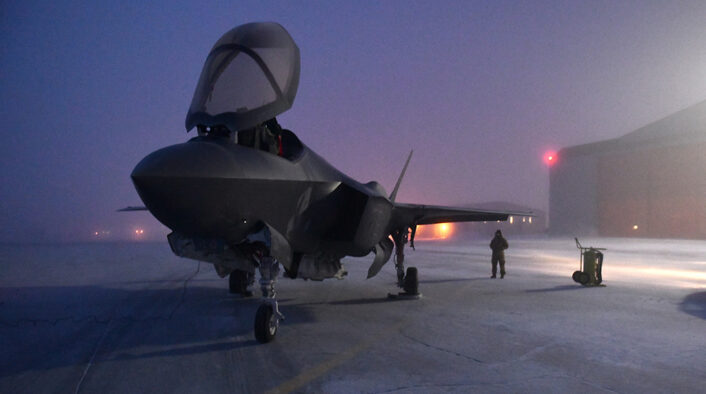The F-35s were involved in Operation Noble Defender in the Arctic Circle.
For the first time, F-35A Lightning II aircraft of the U.S. Air Force were deployed to Greenland, to take part in Operation Noble Defender, a long-planned NORAD (North American Aerospace Defense Command) series of drills whose aim is to assess the command’s capability and readiness to defend the U.S. and Canada in the Arctic environment.
The exercise, underway between Jan. 15 – 31, 2023, saw the involvement of American and Canadian personnel and aircraft from all three NORAD Regions that deployed to Thule Air Base, Greenland, Iqaluit Forward Operating Location, Nunavut, 5 Wing Goose Bay, Newfoundland and Labrador, and from Eielson Air Force Base, Alaska. According to NORAD, approximately 225 USAF and RCAF (Royal Canadian Air Force) personnel supported the operations of four F-35s, three CF-18s, four KC-135s, one CC-150, one E-3, and one CH-149.
Photos released by the DoD via the DVIDS hub show F-35A Lightning II aircraft on the ground at Thule Air Base, on the northwestern part of Greenland, as they prepare for take off on Jan. 16, 2023. Interestingly, one of the images, shows at least an AIM-120C/D AMRAAM (Advanced Medium Range Air-to-Air Missile), carried in the internal weapons bay of one of the F-35A.
This was the first time the F-35s deployed there, “displaying the agility of capabilities in support of Arctic defense with support from the Kingdom of Denmark to allow air defense operations from this location.”
During the drills, NORAD fighters exercised an intercept of a U.S. Strategic Command B-52 representing a threat platform to demonstrate the command’s ability to conduct globally integrated layered defense. NORAD CF-18s escorted the U.S. bomber as it was transiting through northern Canada and the central United States.
In the same period, Russian Aerospace Forces also conducted drills in the Arctic region.
Two Tu-160 strategic bombers of Russia’s Aerospace Force have conducted a patrol over international waters of Arctic Ocean, Russian Defense Ministry said on Jan. 17.https://t.co/OpqXn2bcsL https://t.co/hbKauekoNB
— Ryan Chan 陳家翹 (@ryankakiuchan) January 17, 2023
“Our ability to operate in the Arctic is critical to our ability to defend our homelands,” said General Glen VanHerck, Commander, North American Aerospace Defense Command and US Northern Command in a public statement. “Operation NOBLE DEFENDER successfully demonstrated our willingness and capability to conduct operations above the Arctic Circle in even the harshest weather conditions, and proved a concept of integration with key Arctic partners to defend northern approaches to North America.

As a side note, the shots show the F-35 operations on ice-covered aprons/runway. For operations in the Arctic environment, F-35s can be equipped with a drag chute, housed in a special fairing on the upper rear fuselage between the vertical tails, that can be used to rapidly decelerate after landing on icy runways under windy conditions. At the moment, only Norwegian F-35s are equipped with the drag chute pod. According to the official F35.com website, the pod “distinguishes Norwegian, Danish, Dutch and Belgian F-35As from other F-35s,” although the system is at the moment used only by the RNoAF jets.









